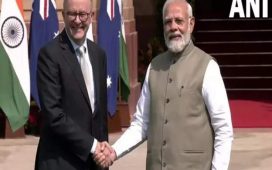Exports of goods and services rose 1.5% to $385.4 billion in the first six months of the calendar year as against $379.5 billion in the corresponding period a year ago while imports dipped 5.9% to $415.5 billion from $441.7 billion in January-June 2022.
In merchandise trade, exports fell 8.1% to $218.7 billion, while imports contracted 8.3% to $325.7 billion.
“Data is showing modest decline due to weak global demand and losing competitiveness in labour intensive sectors,” said GTRI Co-founder Ajay Srivastava.
Services exports during the six months grew 17.7% to $166.7 billion, while imports rose 3.7% to $89.8 billion.
India exports goods to 240 countries and out of that, the country’s outbound shipments declined in 134 destinations.Major countries where exports declined include the US, UAE, China, Bangladesh, and Germany. Countries where exports grew include the Netherlands, UK, Saudi Arabia.As per GTRI, 11 of 29 product categories including telecom, pharma and computer and electronics items, contributing to 25% of India’s exports, grew during January-June 2023, over the same period last year.
Smartphone exports trebled to $7.5 billion during January-June this year from $2.5 billion a year ago.
Srivastava said that the decline in merchandise exports happened despite appreciating Indian Rupee.
He said the world trade outlook for 2023 is weak due to a number of factors, including the ongoing war in Ukraine, high inflation, tighter monetary policy, and financial uncertainty.
However, he cautioned that these factors will soon be overshadowed by a spate of new subsidies and protectionist measures by the EU and US.
For example, in the first seven months of 2023 alone, the EU has introduced five regulations on climate change and trade, each of these are essentially measures to curb imports.
Since every big country is into inward mode, India should not surrender its policy space especially in new issues in free trade agreements (FTA) and Indo-Pacific Economic Framework for Prosperity (IPEF), Srivastava said.
He suggested the government be ready to use targeted and precise retaliation to counter unilateral policy decisions like CBAM (carbon border adjustment mechanism) or EU Deforestation Regulation.
India has done this effectively in 2019 by raising tariffs on the US products when the US in 2018 raised tariffs on steel and aluminium.
“Small firms active in labour intensive sectors face 10-15% cost disadvantages due to high cost of capital, low quality grid power, delays at the ports and higher compliance cost,” Srivastava said, adding that production linked incentives are not an answer to product categories where thousands of firms make the same products as it will put non recipients to disadvantage.
He suggested that a horizontal scheme extending 2-3% incentive to every firm in the sector will help in meeting some of the cost disability.
The top 15 countries with which India has the highest trade deficit in the first six months of 2023 include China ($38.1 billion), Russia ($29.6 billion), Saudi Arabia ($12.9 billion), Iraq ($12.5 billion) and Switzerland ($7.5 billion).
As per the report, the share of FTA partners in India’s merchandise exports came down to 26.8% in January-June 2023 from 30.1% a year ago.
Crude petroleum imports fell 7.6% on-year but Russia’s share in India’s import of petroleum crude jumped to 31.3%
from 6.4% in January-June 2022 while the share of imports from all other major suppliers like Iraq, Saudi Arabia, UAE fell in this period.









